| Columns Retired Columns & Blogs |
... loves the sound of second harmonic distortion.

Speaking of force and vigor, the AT-VM95C (conical)—which is even cheaper than the $49 elliptical version, at $34—sounded cool, fast, and powerful but also detailed and invigorating. It played complex recordings, like the Stravinsky Conducts Histoire Du Soldat Suite, with power-packed, pitch-perfect bass, a flawlessly toned and detailed midrange, and enough upper-octave energy to make trumpets, drums, and woodwinds sound lifelike and exciting. Drum impact was spectacular.
Music-pleasure–wise, Audio-Technica's VM95C was the most satisfying cartridge in this survey. It shifted my perspective and made me reconsider what I thought I knew about phonography.
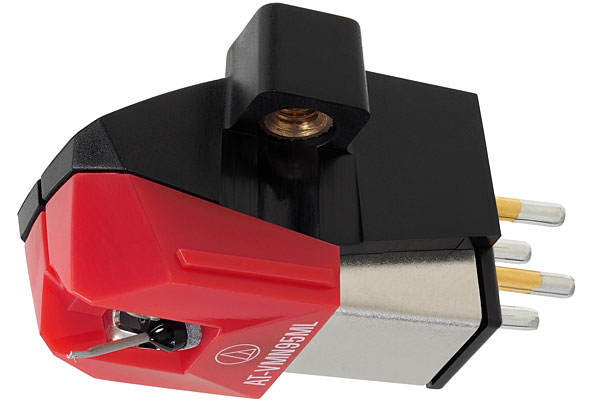
AT-VM95ML
The $169 version of the VM95, the VM95ML, features a nude, square-shanked stylus with a microline profile. Microline styli are narrower and longer than elliptical styli with, supposedly, more contact area with the LP groove wall. During the several days I used the VM95ML, I found myself drawn to early European music, especially records like George Guest directing the Choir of St. John's College, Cambridge, performing Evensong for Ascensiontide (LP, Argo ZRG 511).
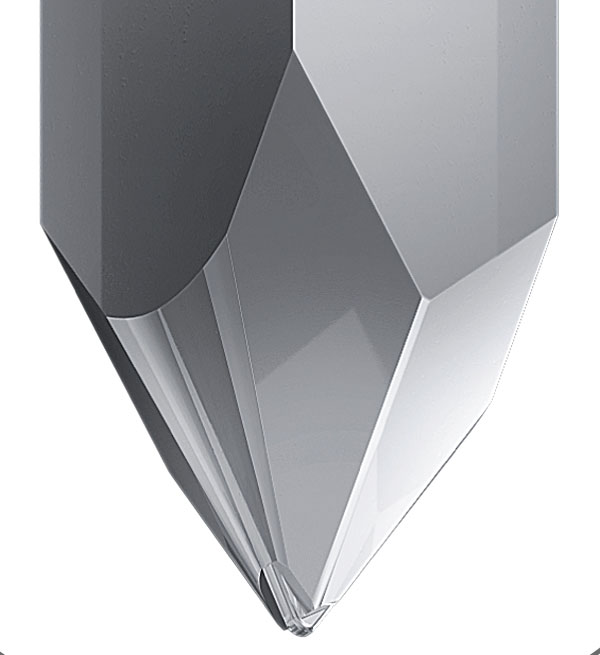
This cartridge, more than any of the others described here, had an exceptional ability to sort and separate voices in a choir. Likewise, this cartridge located the chapel walls and described the venue's pulsing atmosphere as well as did a cartridge costing 10 times as much. This "Ascensiontide Service" uses singing, spoken word, and a magnificent pipe organ to direct the listener's mind heavenward. The VM95ML cooperated by showing me that place where the sonic becomes numinous.
Goldring E3
I first noticed Goldring moving magnet cartridges during the 1990s, when their suave, musical demeanor forced me to buy, first, a model 1040 and then a 1042. For a decade, these overachievers were my go-to moving magnets simply because they played solo piano with an authority that made CD players sound emotionally detached and PRaT-challenged.
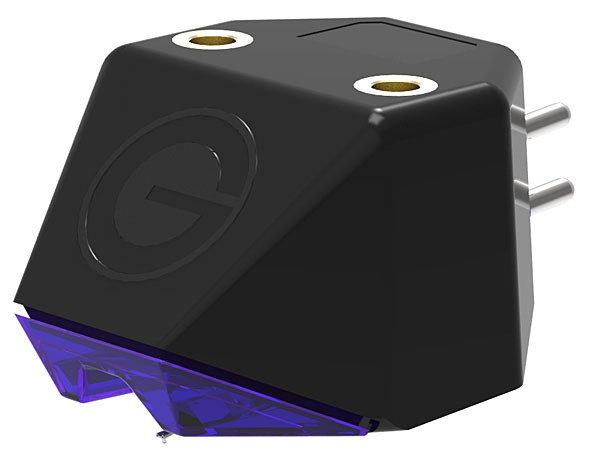
Goldring (footnote 2) introduced the budget E series in 2017. It replaced the popular Elektra and Elan models and consists of three versions: the conical-tipped, carbon-cantilevered E1 ($100), the conical-tipped, aluminum-cantilevered E2 ($129), and the elliptical-tipped, aluminum-cantilevered E3 ($169). The E-series Goldrings are one of those "designed in the UK, made in Japan" products. According to Jonathan Bennett, marketing director for Goldring/Armour Home Electronics, these cartridges are "based around an Audio-Technica generator but with some modifications and improved spec." What I mean by vivid is right there: right in front of me, almost like I could touch the performer.
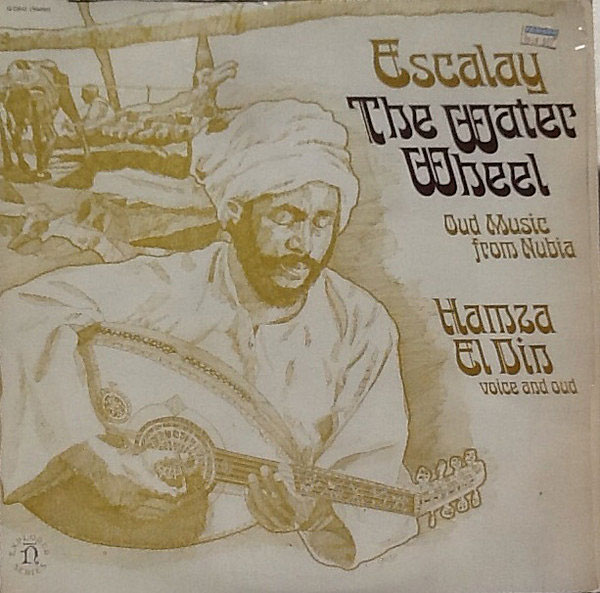
I am looking for a word stronger than "vivid" because, earlier today, in my room, the audio-specter of Hamza El Din was singing and playing his oud with full vividosity just a few feet away, and I was incapable of remembering—or caring—that this vibrant holography was created by a $169 Goldring E3 moving magnet cartridge. El Din's Escalay: The Water Wheel (LP, Nonesuch H-72041) played with much of the realism and complexity it does with a Koetsu. Everything was richly textured. There were no brash, harsh, or generalized sounds. This Nonesuch Explorer Series recording sounded a lot like it did with the Audio-Technica AT-VM95E except smoother and maybe a little softer. Maybe.
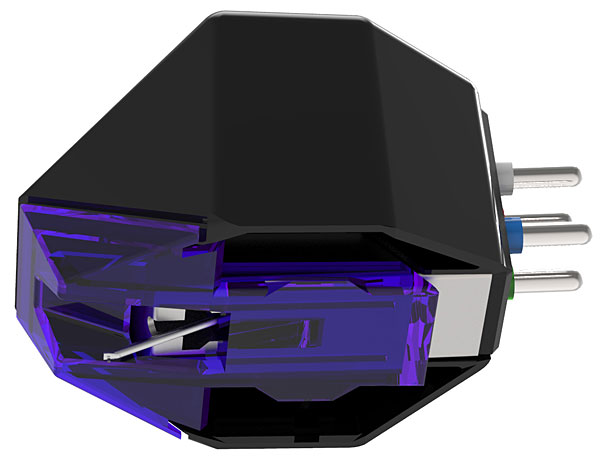
On the Charles Mackerras and the Royal Philharmonic performance of Pineapple Poll (LP, EMI ESD 7028), the Goldring E3 played lean, lacking upper-bass warmth, but oh-my-God (!) did it move this fantastic music along. Talk about PRaT; the music for this Gilbert & Sullivan–inspired comic ballet virtually spins and does cartwheels while racing along at a heart-stuttering pace. The E3 played it with no hesitations. Best of all, the music for this ballet has a wonderful way of filling my mind with images of swirling dresses and starched sailor pants; the Goldring E3 seemed to enhance that quality. It brought out every note with a precision I never imagined a moving magnet could muster.
LP Gear Carbon Fidelity CF3600LE
Based on Audio-Technica's ubiquitous and universally heralded AT3600 ($29), LP Gear (footnote 3) describes their upgraded version, the $49 Carbon Fidelity CF3600LE, as "codeveloped and designed by Audio-Technica with LP Gear." The CF3600LE replaces the aluminum cantilever and 0.0006" conical diamond of the AT3600 with a 0.0003" × 0.0007" elliptical stylus bonded to a carbon-fiber cantilever. The first couple of discs I played with LPG's CF36000LE impressed me with their quiet transparency and smoothness. Then I got an urge for some Slovenian tango, so I played Mascara Quartet's Barco Negro (LP, Sazas VVE LP 001), a clean, simply miked, all-analog recording I know well because I enjoy dreaming to its female vocal, violin, and guitar sounds.
With the $8495 Koetsu Rosewood Signature Platinum moving coil, the pure sensuality of Polona Udovic's singing fosters goosebumps, tears, and lust. At first, the budget cartridge failed to deliver. The CF3600LE's flowing-liquid smoothness dissolved transients and dulled the effect of Polona's voice. I was saddened. I should have been jetting between Buenos Aires and Ljubljana but instead I was thinking, maybe it needs more break-in?
Happily, the floodwaters receded, and the transients returned, after only 12 hours with the CF3600's stylus working silently in Barco Negro's leadout groove. By midnight the same day, every recording I put on played with gleam and sparkle. The CF3600LE was showing itself as quiet, lushly detailed, and engaging, especially on female vocals.
Koetsu Rosewood Signature Platinum
When comparing audio components, sequence is everything. So, please, try to imagine: After weeks comparing entry-level moving magnets, I halted my working-class tourism and replaced the $34 conical-tipped Audio-Technica VM95C with the quadrahedron-tipped, boron-cantilevered, $8495 Koetsu Rosewood Signature Platinum moving coil connected to my $2500 EMIA SUT. The VM95C and the Koetsu both drove the moving magnet input of Sunvalley's SV-EQ1616D phono equalizer.
What did I get for the extra $11,000? Sublime ease and dramatic understatement. Immediately, I grasped how unsubtle the VM95C was. I also received what felt like infinite amounts of micro-level information that showed me room boundaries and microphone locations in recording venues like King's College Chapel and Columbia's 30th Street Studio. The Koetsu made recordings seem infinitely complex and layered in content and sound. The Koetsu gave me fewer distractions and more compelling reasons to disappear into each recording.
However...with the Koetsu, I did not get closer to living performers, as Sanford Gross said I should. The cheap Audio-Technica made me feel closer to the performers. Neither was my heart directed to the "purpose of music" any better with the Koetsu than it was with the VM95C.
What the Koetsu did that made it worth every penny of extra cost was allow me to let out my breath and close my eyes. It forced tension out of my shoulders. It directed my dreamy attentions to the pure sensuousness of its sound and the capaciousness of its spatial illusion. The Koetsu did what it was designed to do: transform the quotidian into the marvelous.
The earth is flat
As I was finishing my auditions, I realized why all these almost-free, give-them-out-on-Halloween cartridges sounded so ridiculously sophisticated: I was playing them on a $6995 two-motor, belt-drive Dr. Feickert Blackbird turntable equipped with a 10.5", $1995 Schick tonearm.
If you are old enough, you might remember that Linn Audio founder Ivor Tiefenbrun used to say that a cheap cartridge on a Sondek LP12 will sound better than an expensive cartridge on a budget deck. Well, I own a 1984 LP12 Valhalla with a Linn Basik LV X arm fitted with an AT95 cartridge, and I have tried a Koetsu Rosewood Signature on a Technics SL-1200 as well as that $699 Pioneer PLX-1000 turntable I reviewed in GD3. I can vouch completely for Ivor's claim.
On the Linn LP12 and the Dr. Feickert Blackbird, the Audio-Technica AT95 sounded dramatically more controlled and powerful, more nuanced and sophisticated, than it ever did on the Pioneer PLX-1000 or that stoop-sale Technics SL-1200 I modified in GD9.
On the Blackbird-Schick deck, these so-called entry-level cartridges played recordings with a layered, three-dimensional complexity that I thought was impossible at these price points. Quiet musical passages were not only quieter; they were filled with magic little details that got noised over, dulled over, or disappeared entirely on the Pioneer and Technics 'tables.
I am not a master cartridge installer, but I can recognize pretty well when a stylus is slipping properly through the grooves. I set VTA/SRA using a few familiar LPs, tweaking arm height until the sound snaps into low-distortion focus. I set azimuth using a Musical Surroundings Fozgometer. I set antiskate so that the arm cartridge moves slowly toward the label on a grooveless disc; then I tweak it a touch more so that it tracks as well as possible on a Shure or Ortofon test record.
I suspect that few audiophiles or reviewers have experienced the capability of these budget cartridges under such perfectionist conditions.
What I learned from this unusual investigation is that the difference between a $100 cartridge and a $10,000 cartridge is not nearly as big as I previously imagined. Also, the difference between a $1000 turntable and a $10,000 turntable is much greater than I thought it was.
If you are a budding phonophile, I recommend buying one of these inexpensive cartridges and putting your car-payment cash into a quiet, solid turntable and tonearm. That way, you can ride the bus while saving for a Koetsu.
Footnote 3: LP Gear, 3024 Via Venezia, Henderson, NV 89052. Tel: (702) 419-0220 Web: lpgear.com

... loves the sound of second harmonic distortion.

Hi
How do you know it is 2nd harmonic, not odd harmonics? Your guess or what?
I ask you because I am using an AT !
Jack L

... objective test data published by Shure nearly half a century ago.

HI
What's wrong with 2nd harmonic distortion ??
FYI, Nelson Pass design/built his well-known Pass H2 harmonic generator some 6 years back for adding such distortion to any audio amp to make it sound better. He used a twin-triode, e.g. 6922, to generate the required distortion.
A musical instruments manufacturer even build such generators in its products, using, similar to Pass, a special designed/built computer chip
"NuTube" of same specs of 6922 twin-triode.
According to Pass, 2nd harmonic distortion might have caused the soundstage image improved depth of an audio amp so distinctly noticeable vs a solidstate audio amp which lacks 2nd harmonic distortion.
Listening is believing
Jack L

... dose of second harmonic distortion to be added to the reproduced sound, then what you appear to be seeking is not merely a neutral amplifier, rather some sort of sound processor - particularly, for example, if you're trying to change the perceived sense of depth inherent in a given recording.
As for musical instrument products, the intent for incorporating a second harmonic generator is likely to create a certain sound effect.

Hi
Sorry, I never stated I "need or want" any distortion in my amps, pal.
I only quoted big guy like Nelson Pass, amp designer/manufacturer, who might "need or want" to add 2nd harmonic distortion in his amps & he invented such thing. !!!!
Jack L

An interesting piece and something that it's good to see stated in a magazine where four-grand-anything is considered 'entry-level', but I'm forced to ask "what's new" here? I bought my first (and last) audiophile TT (a Linn-beating STD 305M) 40 years ago, and with a well-engineered unipivot (Hadcock GH228) found my Nagaoka MP11 -- a sure-footed and noiseless £20 moving-magnet -- to provide all of the realism that I could ever hope for in music reproduction; a realism completely lacking in every digital I've heard since. Similarly, that the hyped-up sound of most moving-coils (both in terms of abilities and frequency-response) that the magazines (and phono preamp designers) entreat us to buy is not really that engaging for anyone other than detail-freaks is also nothing new. That the TT is the most important element in phono replay, followed by the tonearm, and then the cartridge is also axiomatic, the significance of this perhaps lost in the different tonal balances that result from improperly terminated cartridges (see below).
If, however, this piece serves to reacquaint audiophiles with the mechanical and sonic delights of MM cartridges and the frictionless unipivots that enable them to work at their best, then it's about time too. Perhaps now preamp designers can start putting MM inputs into their designs and add 0-600 pf variable capacitance -- not everyone who runs MM cartridges wants to have to spend $10-20K on a Manley Steelhead or Halcro DM10 just to get this feature -- instead of throwing all the effort (and customers money) at multiple gain-stages and transformers for low-output MCs. In this latter, note that there's no easier way to modify the tonal balance of your phono system than by varying the capacitance seen by a MM and it's a lot easier than changing your loudspeakers.
It also goes without saying that MMs (and MIs) allow cheap, easy changing of styli -- who-on-Earth wants to wrestle a cartridge off of a tonearm every 12 months and put it in the post (only to get a new diamond with the same worn old suspension back, whist risking your tonearm bearings every time you do it)? Similarly, although a Koetsu doubtlessly sounds (ten) grand, at a running cost of ~ $10/hr I'm, not sure that I could ever enjoy my music when I know that the cost of the playing is more than the cost of the record being played...

For only $1K, the Pro-Ject Phono Box RS and the iFi Micro iPhono3 Black Label phono preamps both offer user adjustable load capacitance over a range from 100pF to 500pF.
https://www.project-audio.com/en/product/phono-box-rs/
https://ifi-audio.com/products/micro-iphono3-bl/

100pf is far too high for a minimum (needs to be 0pf), neither auto-mute during selection so neither can be used during listening to tailor response, and the iFi isn't really an audiophile device and doesn't have anything like the necessary reliability (look the latter up).

... offers a load capacitance range from 47pF to over 1300pF.
https://www.lehmannaudio.com/phono-stages/decade.html

...the Lehmann stuffed with opamps and ICs, so again not an audiophile component (or, at least, one that could have been much better without such laziness/economy of design)

... believes in op-amp myths rather than op-amp facts.
https://nwavguy.blogspot.com/2011/08/op-amps-myths-facts.html

Nope, and please save your comments for someone who gives a fk what you think -- I didn't ask for your anecdotal, I replied to the Author of the article, not You. Someone tells you that opamps are best as 'Fact' and you believe it. Good for you -- I suppose you think that digital is best too. Reread my 'typical' comment where I say that the amplifier "...could have been much better without such laziness/economy of design" and try to understand what that means -- an opamp is one person's or group of people's idea of what 20 or 30 components sound good together, nothing more, and it has no magical (or 'factual') properties that make it better for that -- it is simply an assemblage of discrete components where the designer doesn't get to choose. If you think that buying an off-the-shelf melange of components all soldered into one indivisible lump is the way to design audiophile components then you are as naive as your unrequested comments make you sound.
Now go and troll someone else.

Hi
So please tell us what do YOU know about the "op-amp facts".
I am all ears!
Jack L

... I've been using various preamp, tuner, recorder and digital disc player products that incorporate op-amps and haven't been able to identify any particular shortcomings that relate to their use.
What seems to be your concern with op-amps?

..........incorporate op-amps" quoted Ortofan
Hi
So you have been "using various preamps" as a consumer. Apparently your ears were not sensitive or critical enough to tell the sonic difference between preamps/power amps using discrete active devices: transistors, FETS, tubes vs op-amps.
So you don't know at all what are the FACT about the design of an op-amp, correct ?
So why you quoted me some lead to read on the "myth" & "fact" about an op-amps in yr previous post to me when you don't even know what is it all about ?
Am I selling coconuts to an Eskimo who never knows coconut in its life ?
Jack L

Very curious as I have often thought that My Shure M97 with an upgraded stylus was still too polite. Need some excitement and we will see if $57.88 with shipping from LPGear is it.

Hi
I bet you would like it.
Despite I am still playing with my MC cartridge made in Japan, I still play with my vintage AT MM cartridge with CONICAL stylus for its relatively high voltage output@47K load for my design/built low-gain
single-stage RIAA phonostage. They match up flying colour !
It plays demanding fire-cracker music, like Tchaikovsky 1812, etc, no sweat !!
Listening is believing
Jack L

I'll have to buy that stylus and give it a whirl.
I actually have an older AT conical cart, but I'll have to find out what model it is. Kind of a creamish/light gray stylus plastic front.

Hi
My VM gets a white square vertical stylus plastic front. Pretty easy to clean the needle.
Jack L

is something, but not everything. Among the items listed for their longevity, one could say that their success is due to their pleasing nature (with the exception of the K-Horn, which I have never heard sound "pleasing.")
The virtues of vinyl are easily evident in a modest playback system so long as two criteria are met: lack of turntable noise ("rumble") and reasonably unvarying pitch ("flutter and wow"). Fortunately, those two demons have been well exorcised during the past decades, even with tables at modest -- 3-figure -- prices.
Beyond that, it's about detail and subtlety . . . and personal taste. More money usually buys more of those, but realizing these extra benefits also requires a higher proficiency in setting the table up. So, unless you're Mike Fremer, buying an expensive table/arm/cartridge from a knowledgeable specialist who will set it up for you is probably money well spent.
As for MC vs. MM, I made the switch to MC (plus step-up) some years ago. The difference was not "jaw dropping" and, I found was something of a matter of taste. Unfortunately, the cost of the conversion includes both the cartridge and the step-up. MF's recent glowing review of an MM cartridge in about the price range of my MC, has tempted me to consider going back to MM, rather than investing more in a "better" step-up and MC cartridge. Fortunately, my BAT phonostage has all kind of options for changing resistive and capacitive loading. Years ago, BAT man Victor Khoumenko kindly set me an assortment of parts that plug in to sockets on the circuit board to alter these parameters, with instructions.
With vinyl, once an acceptable level of turntable noise and speed accuracy is reached (which, these days, doesn't require 4-figure money), its more about what you're missing when you don't spend more money.

not that you needed to hear it from me. I think of how far it has come from my Dual 1209, or the Edison Cylinder. There are almost too many choices for someone getting into vinyl.
There is a great moment in the "Now Hear This" series with Scott Yoo, season 2, about Mozart where an owner of an MBL System has pristine Edison Player and numerous cylinders to play. After that they listen on the MBL System. Oh to be a fly on the wall for that.

I haven't had a turntable for many years, since eschewing them for the convenience of CDs, once I found my Arcam CD player than didn't sound thin and sterile like most I could afford. But, back in the 70s and 80s when I still had vinyl, I found that my favorite ADC moving magnet cartrdiges, and the AT ones, had more punch and life than the more lauded Shure and Stanton offerings, or the MC ones I heard, which were mostly Ortofon and Denon. And, I couldn't afford a step-up transformer, or be annoyed by a cartridge that had to be sent back to the factory for styli replacement. I also preferred direct drive turntables over belt drive for the same reason, they sounded more exciting, alive, and realistic to me. And, I see that direct drive is now making somewhat of a comeback in audiophile circles, to which I say "It's about time. What took you so long?"

Thoroughly enjoyed reading this, but I still do have some caveats/questions. I remember these cheaper Audio Technicas were great entry level cartridges, including the Linn K5 that came as a freebie with my LP12 when I bought my first one in 1989. I used it for a few days then installed my trusty Shure V15 MK V MR cartridge. The problem I had with the K5/Audio Technics, was that it sounded a little hot and zingy, if I can use that term with the top end. That is cymbals and high hats sounded a little hi-if-ish with a brightness that at first sounded attractive but over longer listening began to sound fatiguing. I noticed this same brightness today listening to a mono Clifford Brown recording I purchased yesterday from Academy Records in NYC. Through my Cyrus phono signature/PSX-R2 which allows for remote controlled loading changes, a 10db drop in gain resulted in a less bright and less forward sound but more enjoyable over long term listening. Could it be this is the sound that Herb Reichert and others have fallen in love with these cartridges?
It is great that Audio Technica offers different stylus choices for the cartridge in question, as much as I think MC’s are superior and by quite a margin over MM, I too have been using an MM cartridge for the last thirty years because I hate the idea of paying so much for a top tier cartridge, only to have to change the cartridge after 500-1000 hours of playing. Still, I do think on my tonearms with a removal headshell I might be tempted to pay a little more for an MC cartridge, as it is a far more natural sounding than an MM.

For this, I hope you do more of these.

.... Listening #186: "I continue to prefer the spherical experience—..." quoted Herb Reichert.
Great minds think alike !
I fully concur with Art's sonic preference to conical stylus: more AIR, more AMBIENCE & more OPEN from my vintage AT-VM MM cartridge with conical stylus than my MC cartridge(Japan origin) with elliptical stylus.
Listening is believing
Jack L

on my Dual 502 with a Rega 202 (250)arm. Very nice. Cart pins are slightly larger than the ones on my Shure M97.
Sound at least as good as the M97, clear, good bass and probably the best $50 cart I've ever owned. Now to try some styli upgrades. HR was right on about this cart. It may be all that many people need.

I kid you not, when properly set up and paired with a quality MM phono stage (e.g. an iFi iPhono2 with iPower Elite), this ~USD$50 cartridge sounds so airy and supple, much like a Koetsu or high-end ZYX. Every vinylphile should get at least one of those into her/his system to see how a cheap cartridge can, in almost every thinkable sonic category, perform better than a lot of super expensive ones. I do have several >USD$10k cartridges for reference, BTW.